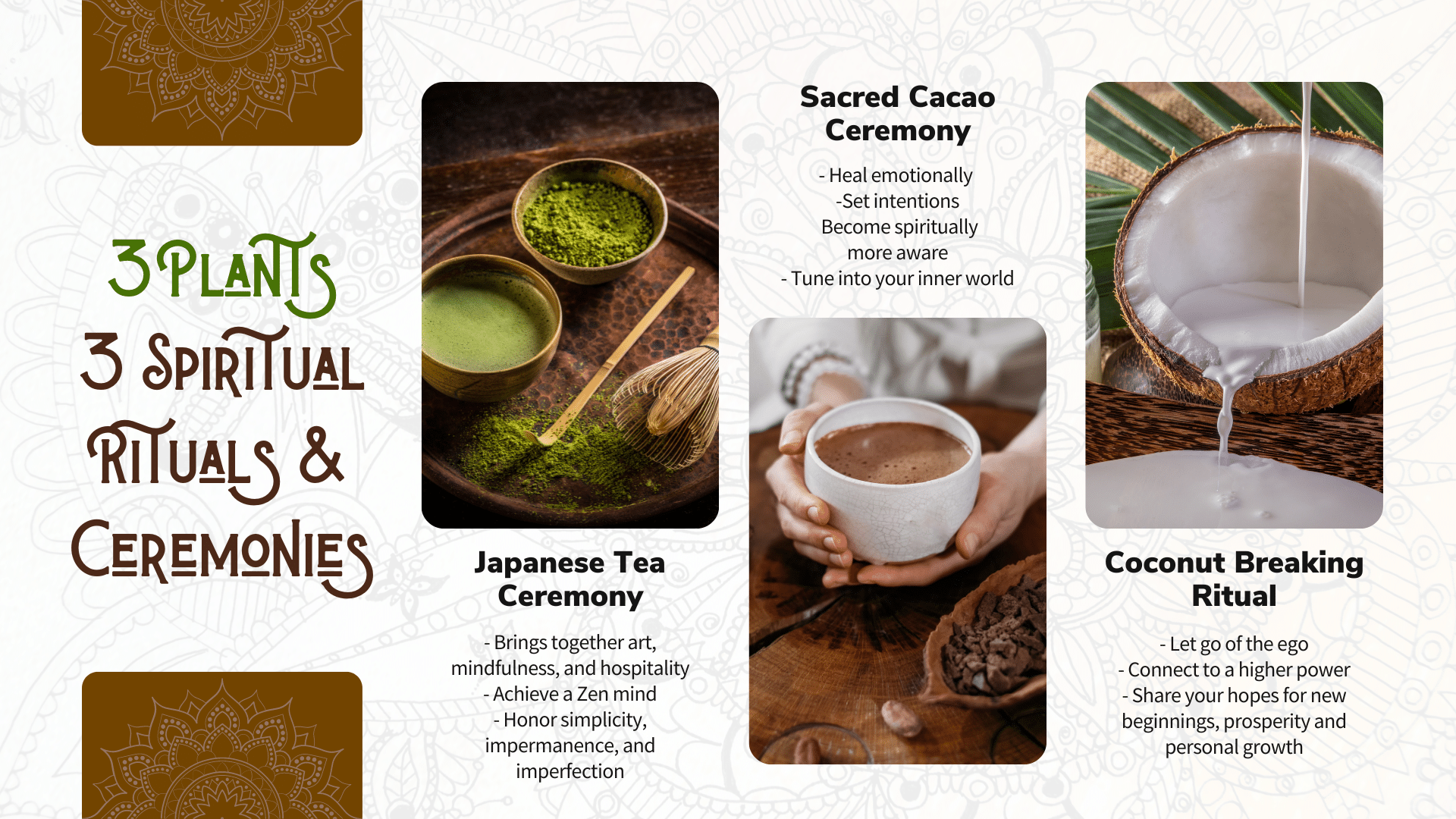
24 Sep 3 Spiritual Rituals and Ceremonies to Support Your Growth
Spiritual rituals and ceremonies often use plants that have a special spiritual significance in each culture, in addition to their culinary value. The purpose of this article is to introduce three specific plants – cacao, coconut, and matcha tea – that all contribute to the richness of spiritual practices around the world. Let’s explore how these plants are used in different cultures and their role in rituals that help people get closer to themselves and the universe.
It goes without saying that a healthy lifestyle includes eating right, getting enough sleep, and exercising regularly. But it goes beyond that! We can also live our best lives by engaging in spiritual activities such as prayer, meditation, and ritual. They have the power to cultivate inner harmony and peace, which opens our hearts, dissolves emotional barriers, and ultimately increases our vitality to face the challenges of everyday life..

The Japanese Tea Ceremony
This ultimate Japanese experience has been around for centuries and brings together art, mindfulness, and hospitality in a simple yet profound ritual.
The Heart of the Ceremony: Matcha Tea
Matcha, a powdered green tea, is thought to have been first discovered by Zen monks in 9th-century China and then introduced to Japan by a Buddhist monk at the end of the 12th century. Matcha tea was originally used as a means of staying alert during long hours of meditation to achieve a Zen mind.
What Is The Importance of Tea in Japan?
In the West, tea is often enjoyed for its health benefits or simply as a way to warm up. But in the East, the process of brewing and drinking tea goes far beyond that, as it is a form of fine art and a meditative practice that engages all the senses. Over the centuries, this ritual evolved into the refined Japanese tea ceremony, a social tradition embraced by people of all classes, from commoners to samurai. For the samurai in particular, the tea ceremony offered a peaceful escape from the chaos and violence of the sixteenth century – a moment of calm in an otherwise turbulent world.
What Is the Philosophy Behind the Tea Ceremony?
First, the Japanese tea ceremony, also known as chanoyu, chado, or sado, serves to educate and cultivate the Zen principles of harmony (wa), respect (kei), purity (sei), and tranquility (jaku).
Second, the ceremony is firmly grounded in the philosophy of wabi-sabi, which honors simplicity, impermanence, and imperfection as beautiful aspects of the natural world. Every action in the tea-making process, from choosing the right instruments to arranging the movements, has symbolic significance and is intended to focus your attention on the here and now.
Third, the spirit of ichi-go ichi-e, which translates to “one time, one encounter,” is observed in this mindful ritual and serves as a gentle reminder to appreciate each interaction as a unique, once-in-a-lifetime opportunity.
What Does the Tea Ceremony Look like?
There are two main types of tea ceremonies in Japanese culture: Chakai and Chaji. Chakai is a simpler, more casual gathering where matcha tea is served with traditional Japanese sweets (wagashi). Chaji, on the other hand, is a more elaborate, formal event that follows a strict set of customs. It also includes a multi-course haute cuisine meal known as kaiseki and two different methods of preparing and serving tea.
With faster, gentler movements and more water, usucha is the lighter and thinner variety, with a softer flavor. Koicha has more matcha powder and less water, making it a thicker and stronger sensory experience. Only the best tea leaves are used, and the strokes are slower and more deliberate.
The Sacred Cacao Ceremony
This heart-opening ritual is all about taking the time to prepare and consume cacao in a mindful way to help participants heal emotionally, set intentions, and become more spiritually aware.
The Heart of the Ceremony: Cacao
Cacao has been a part of our lives for thousands of years. The ancient Mayans and Aztecs revered it for its mystical qualities, which they believed nourished both the heart and the mind. When Spanish conquistadors introduced cacao to Europe, it immediately became a popular treat, but its rich heritage and pure essence were preserved.
Today, ceremonial cacao gives us a way to connect with this ancient wisdom. Made from raw, unprocessed cacao powder, it is the purest form of cacao available – unlike the processed cacao found in many modern sweets.

A ritual is the enactment of a myth. And, by participating in the ritual, you are participating in the myth. And since myth is a projection of the depth wisdom of the psyche, by participating in a ritual, participating in the myth, you are being, as it were, put in accord with that wisdom, which is the wisdom that is inherent within you anyhow. Your consciousness is being re-minded of the wisdom of your own life.
What Is the Power of Cacao in Your Spiritual Practice?
The key ingredient in cacao is theobromine, a natural compound similar to caffeine but with a more balanced, long-lasting effect. Unlike caffeine, it’s not addictive and provides a gentle stimulation.
The beauty of cacao is that it affects everyone differently. Some people feel energized and alert, while others experience a deep sense of calm and serenity. This is due in part to the endorphins that cacao helps to release, which elevate mood and create a sense of well-being.
What Makes the Simple Act of Drinking Cacao a Spiritual Ritual?
A Cacao Ceremony is more than just sipping this sacred beverage. This guided meditation is meant to bring you into a state of spiritual self-awareness where it becomes easier to tune into your inner world, open to transcendence, and find peace in the present moment.
Many participants come to these ceremonies with questions or dilemmas they wish to resolve, and the experience often helps to shift their mindset and bring new perspectives in a safe environment.
Before attending a Cacao Ceremony, it’s recommended that you prepare your body and mind by adjusting your diet. If possible, avoid sugar, alcohol, and caffeine on the day of the event, and opt for simple, clean, plant-based meals to better align with the energy of the ceremony.
Start measuring today
Use the Egely Wheel to measure how your spiritual practice affects your vitality.
See how releasing emotional barriers, opening your heart, cultivating inner harmony, or focusing your attention can change your life energy level for the better.
The Coconut Breaking Ritual
This symbolic act is found in various cultures and represents letting go of the ego and embracing spiritual purity. By cracking open the coconut, participants show their connection to something bigger and share their hopes for new beginnings and personal growth.
The Heart of the Ritual: Coconut
Referred to as the “Tree of Life,” the coconut palm thrives along the sun-kissed tropical coasts of more than 80 countries, where every part of the plant has its uses. From the fibrous husk that is spun into textiles like rope and netting, to the nourishing coconut oil that is popular in beauty and health routines, the coconut palm is a cornerstone of local economies and diets. Even the sap plays a vital role, transformed into local delicacies like palm wine and sweet syrup.
In the Maldives, for example, the coconut palm is considered the tree of the nation because of its versatility. According to folklore, when the first settlers died, a sorcerer turned their skulls into coconut trees, giving the remaining islanders the resources (such as food, drink, and materials for building and crafting) they needed to survive.
In India, one of the largest exporters of coconut and coconut-based products is the state of Kerala, also known as the home of Ayurveda.
What Is the Religious and Cultural Importance of the Coconut for Spiritual Practice?
In many parts of India, coconuts are deeply spiritual and culturally significant. Historically, Sanskrit texts have glorified coconuts, emphasizing their function in promoting a pure, beautiful, and tranquil atmosphere. They represent fertility, prosperity, and protection from evil, and are therefore considered crucial in a variety of auspicious occasions, from festivals and marriages to everyday acts such as buying a new house or opening a new business.

What Is Symbolized by the Ritual of Breaking the Coconut?
Those who ritually break coconuts and make offerings to God are basically saying to God that they’re willing to surrender to Him. It’s nothing but sincere devotion and love for their faith.
And what is the symbolism associated with each of these coconut-breaking steps? Peeling a coconut husk is a metaphor for the inner desires and materialistic ambitions we need to let go of. The need to break our ego is symbolized by breaking the coconut in half. The water that comes out of the coconut symbolizes all the negativity that must leave our body and mind. The soft inside of the coconut is a symbol of peace.
It’s interesting to note that because the coconut is seen as a symbol of life, pregnant women are discouraged from breaking it, as it’s seen as killing a life form. There’s also the belief that the sound of breaking a coconut is harmful to the fetus in the womb.
The Sacred Art of Everyday Rituals
In each of these spiritual rituals – whether it’s a cacao ceremony, the cracking of a coconut, or the traditional Japanese tea ceremony – the essence is mindfulness, intention, and presence. What these spiritual practices have in common is their ability to turn the ordinary into something special.
As you infuse each step with intention and respect for yourself and the world around you, you will remember the value of slowing down and not taking things for granted.
So the next time you take the time and attention to make and drink your matcha tea and cacao, or crack open a coconut, think of it as your own spiritual practice to help you grow. It is your moment to give thanks to the universe, to be in the moment, and to quiet your mind in a noisy world.
10 Sources +
Egely Wheel has strict sourcing guidelines and relies on peer-reviewed studies, academic research institutions, and medical associations. We avoid using tertiary references.
- The reason behind breaking coconut on auspicious occasions – https://timesofindia.indiatimes.com/
- The use of coconut in rituals and food preparations in India: a review – https://journalofethnicfoods.biomedcentral.com/
- Japanese Tea Ceremony – https://www.japan.travel/en/
- Chanoyu: The Japanese Art of Tea – https://education.asianart.org/
- Cocoa Ceremony: A ritual for more self-care and connection – https://www.theyo.de/en/
- What Is Cacao Ceremony? Cacao Preparation, Rituals, Physical And Metaphysical Benefits – https://www.breakfastcriminals.com/
- From mythology to cuisine, cultural and culinary journey of coconuts in India – https://indianexpress.com/
- What Is a Cacao Ceremony & What Are Its Benefits? – https://aerialbvi.com/
- What is a cacao ceremony? – https://cpduk.co.uk/
- Tea Ceremony in Japan – https://mai-ko.com/

